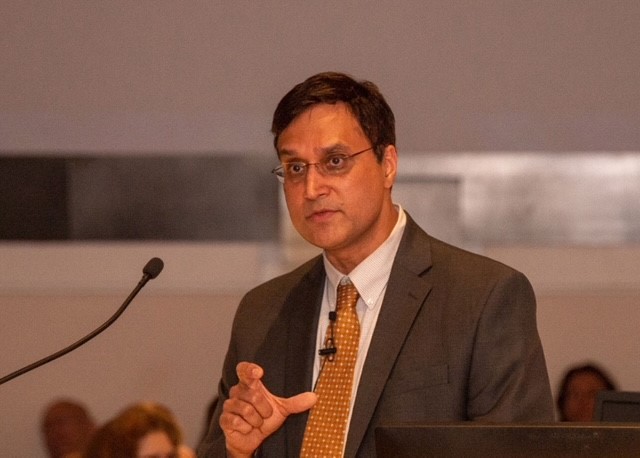Research Aims to Advance Medicine Production by Microbes
August 17, 2016
The National Science Foundation has awarded $616,012 to Davidson College to support three years of continuing faculty/student research into new methods of producing metabolically engineered bacteria. The research could produce useful compounds for applications in energy, agriculture, pharmaceuticals and bioremediation of toxic waste sites.
This project, entitled "Collaborative Research: RUI: Broadening the Application of Programmed Evolution for Metabolic Engineering," is under the direction of Professor of Biology Malcolm Campbell and Kimbrough Professor of Mathematics Laurie Heyer, in collaboration with a lab at Missouri Western State University (MWSU).
The two schools have been cooperating on summer research projects for more than a decade, and the grant will finance that collaboration for three more years.
Vexing Problem
A team of a dozen undergraduates at Davidson and MWSU conducted basic research this summer on a problem which has long vexed scientists. At issue is the fact that microbes producing medicines usually lose production capacity as they evolve, and must constantly be replaced.
The Davidson/MWSU team project, using a method called Phage-Assisted Continuous Evolution (PACE), inverts the metabolic engineering paradigm by harnessing evolution instead of fighting it. The new approach constantly optimizes medicine production by microbes through natural selection that rewards cells for optimal drug production.
"We engineer molecules so that cells which produce the most drug, grow the best," Campbell said.
Using the PACE method, a population of bacteria is programmed with DNA software to compute solutions to a metabolic pathway optimization problem, and evolution is used to direct the bacterial population toward optimal solutions. An essential element of this approach are molecular switches.
Novel Approach
In order to evolve new molecular switches inside cells, the cells must be able to sense a particular compound that flips the molecular "riboswitch" and activates the natural selection process.
The Davidson/MWSU research represents the first rapid method inside living cells to discover new switches that respond to a variety of small pharmaceuticals.
"The coolest part of this method is that viruses which infect bacteria evolve so quickly," Heyer said. "We can evaluate trillions of DNA sequence variants in search of the right one. We could never accomplish such an exhaustive search without PACE."
The goal of the current project is to adapt PACE to discover new riboswitches used for optimal production of useful compounds.
Chemists at Harvard University developed PACE in 2011 and refined the method in a 2014 paper. Campbell and Heyer learned about PACE while attending the Institute for Biological Engineering annual conference with last summer's research students. Harvard scientists helped the Davidson and MWSU teams jump-start this summer's research by sharing DNA with them.
The PACE project reached the proof-of-concept stage this summer, attempting to evolve a switch that currently senses theophylline (a drug under a variety of brand names used in therapy for respiratory diseases, such as COPD and asthma) into one that can sense a different compound.
The two mentors are optimistic the procedure can be applied to a host of drugs.
"We're taking baby steps first, but if this process works, we should be able to publish the method for discovering new riboswitches, and scale up the process to discover many new switches," Campbell said.
Longtime Collaboration
The summer research was another example of long distance collaboration on cutting-edge research between Davidson and MWSU. These projects have been supported through the years by other grants from the National Science Foundation, the Howard Hughes Medical Institute and the James G. Martin Genomics Program.
Students learned to work remotely with their partners, keeping track through a variety of communication tools.
"They learned what it takes to keep your partner up-to-date from 1,000 miles away. Learning to communicate clearly is an important life skill in work as well as any relationship," Campbell noted.
Campbell and Heyer are particularly proud of the interdisciplinary nature of the project. The six Davidson undergraduates represent a wide range of academic majors -- biology, chemistry, physics, bioinformatics and two who are undecided.
This summer's work began with a visit to Davidson from the MWSU team to discuss the project. Students were paired with a student from the other school, and worked together from afar on a particular aspect of the project. Faculty on both campuses served as resources, but the student teams were responsible for the day-to-day aspects of their research. The Davidson team traveled to MWSU for four days at the end of the summer to conclude the 10-week experience.
Student Innovation
"Our students were undaunted by the fact that there are only three other labs in the world using PACE," Heyer said. "They exercised a tremendous entrepreneurial spirit. They identified and embraced the need, and figured out how to solve problems on the fly. This procedure isn't clearly explained anywhere."
The research required a new device called a chemostat that would cost $30,000 if purchased off the shelf. The Davidson team trimmed that cost in half by ordering individual components of the machine, and letting physics major Cody Herron '17 construct it.
"It's like making a Lego structure," Herron commented. "But you've lost the manual and are trying to build it by just looking at the finished picture. And it's fun, I've always liked Legos!"
In another student-initiated innovation, bioinformatics major Dylan Maghini '17, who holds the Lawrence D. Long Scholarship, developed from scratch, in just a few days, a program to model PACE on a computer.
"The model allows us to adjust parameters virtually to see how our experiments are likely to work before we actually do them in the chemostat," she said. "The big picture goal is to produce molecular riboswitches that could recognize different drugs. Currently, there are very few switches known to science, and were trying to discover new ones."
Biology major Anna Buser '18 helped build and verify DNA constructs used to evolve new switches, and chemistry major Zach Shaver '18 worked on mutating switches, which control protein production in cells.
With the new grant from NSF, Campbell and Heyer are excited at the prospect of forming a completely new student research team next summer, and are confident that the collaboration between students will eventually yield publishable results.



